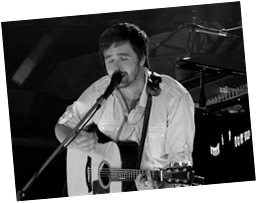When big events like the Country Radio Seminar occur, Music Row begins to buzz with various activities and talk about the celebrities. The Country Radio Seminar is an annual convention designed to educate and promote the exchange of ideas in the country music industry. This year marks the event’s 40th anniversary and it promises to be another great year for attendance.
Among the buzz this year is Gerry House’s induction into the Countr y Music DJ Hall of Fame. House is without a doubt one of the most well known country radio personalities of all time and has been honored many times during his long career as a spinner of vinyl (and now polycarbonate, or make that digits!). He began that career in the small Tennessee town of Maryville at WBCR. In 1975, he stared at WSIX-AM in Nashville then moved over to the FM side in the early ’80s. In 1985, he moved his show to the granddaddy of Country Music Radio, WSM and then to KLAC in Los Angeles. Ultimately, as life often does, he came almost full circle returning to WSIX-FM. In 2008, the Gerry House and the House Foundation morning show on WSIX won “Personality of the Year” awards from the Country Music Association, the Academy of Country Music and Radio & Records. House also received the National Association of Broadcasters’ Marconi Award and Leadership Music’s Dale Franklin Award. Also an accomplished songwriter, House wrote “The Big One” (George Strait), “Little Rock” (Reba McEntire) and “On The Side Of Angels” (LeAnn Rimes). House is joined by the induction Cleveland Ohio’s Chuck Collier, a 30-year veteran of country music radio. On the programming side of the equation, Bob McKay and Moon Mullins are the Country Music Radio Hall of Fame inductees. Merle Haggard will receive the Career Achievement Award and Shelia Shipley Biddy will be presented the President’s Award.
y Music DJ Hall of Fame. House is without a doubt one of the most well known country radio personalities of all time and has been honored many times during his long career as a spinner of vinyl (and now polycarbonate, or make that digits!). He began that career in the small Tennessee town of Maryville at WBCR. In 1975, he stared at WSIX-AM in Nashville then moved over to the FM side in the early ’80s. In 1985, he moved his show to the granddaddy of Country Music Radio, WSM and then to KLAC in Los Angeles. Ultimately, as life often does, he came almost full circle returning to WSIX-FM. In 2008, the Gerry House and the House Foundation morning show on WSIX won “Personality of the Year” awards from the Country Music Association, the Academy of Country Music and Radio & Records. House also received the National Association of Broadcasters’ Marconi Award and Leadership Music’s Dale Franklin Award. Also an accomplished songwriter, House wrote “The Big One” (George Strait), “Little Rock” (Reba McEntire) and “On The Side Of Angels” (LeAnn Rimes). House is joined by the induction Cleveland Ohio’s Chuck Collier, a 30-year veteran of country music radio. On the programming side of the equation, Bob McKay and Moon Mullins are the Country Music Radio Hall of Fame inductees. Merle Haggard will receive the Career Achievement Award and Shelia Shipley Biddy will be presented the President’s Award.
The Country Music DJ and Radio Hall of Fame events unofficially mark the beginning of CRS each year. The Hall of Fame Cocktail Party begins at 5:30 p.m. Tuesday evening. The Dinner and Induction Ceremony follows at 6 p.m. The remainder of scheduled events for CRS are as follows:
Wednesday, March 4
Wednesday’s events kick off at 9 a.m. with the Opening Ceremonies and Award Presentation. The keynote address, delivered by marketing expert Seth Godin, will follow at 10 a.m. in the Performance Hall, with the  Motivational Speaker/Life Coach panel at 11:15 a.m. This year’s speaker will be former No. 1 country artist-turn motivational coach Sylvia Hutton.
Motivational Speaker/Life Coach panel at 11:15 a.m. This year’s speaker will be former No. 1 country artist-turn motivational coach Sylvia Hutton.
New label Golden Music will sponsor Wednesday’s luncheon, featuring performances by Benton Blount and Williams Riley. The previously scheduled morning Artist Radio Taping Session (sponsored by SESAC) will now be combined with the afternoon A.R.T.S. panel. As a result, the afternoon session will be extended by one hour (2:30 p.m. – 4:50 p.m.).
Performers at ASCAP’s KCRS Live! will include artists and songwriters Jimmy Wayne, Kelley Lovelace, Ashley Gorley and Jonathan Singleton. The popular Music City JamTM (7:30 p.m. – 9:30 p.m. in the Performance Hall) will be hosted this year by Tim McGraw and sponsored by the Academy of Country Music.
Additionally, two educational panels will be featured Wednesday afternoon: “Country Radio As Seen Through The PPM Lens,” sponsored by Arbitron, and “Back to the Future: 1969-2049.”
Thursday, March 5:
Designated as Music Industry Town Meeting Day, single day registration for Thursday’s activities may be purchased on-site for $265. The day’s agenda includes the return of the Tech Track and Small Market Track panels. Tech Track panels include “Spinning a Web” and “40 New Media Ideas.” Small Market panels include “Come Hell or High Water: Disaster Preparedness,” “You’re a PD, Now What?” and “Champagne Production on a Beer Budget.” Sixteen panels will be offered in all during the day between 9 a.m. and 4 p.m.
Thursday’s events begin at 9 a.m. with The Country Music Association revealing the results of its 2008 Country Music Consumer Segmentation Study, conducted by Leo Burnett Co. and Starcom MediaVest Group. Sony Music Nashville’s luncheon (noon – 1:50 p.m.) will feature performances by Miranda Lambert and Jake Owen. At 4:10 p.m. Bobby Pinson, Pau l Overstreet, Josh Turner and Jamey Johnson will perform during WCRS Live! (sponsored by BMI and Country Aircheck).
l Overstreet, Josh Turner and Jamey Johnson will perform during WCRS Live! (sponsored by BMI and Country Aircheck).
Friday, March 6:
Friday is Radio Sales Day. Single day registration, including entrance to the New Faces of Country Music Show®, is available for $370 on-site. Friday’s events will kick-off with the Managers’ Breakfast at 8 a.m., followed by CRS-40’s second research study, which will present findings from the Edison Research / CRB National Country P1 Study 2009 at 10 a.m.
Panels during the day will focus on important topics that affect the Country Radio format, such as consumer habits, promotional and research ideas, voicetracking and tools to increase sales. Prominent sales panels include “20 Ideas Even a PD Would Love,” “PPM! Selling the Country Format,” “What’s NTR Got To Do With It?” “Creative Closing” and “A Car Dealer Tells All About Advertising.” More than a dozen panels will be offered during Friday’s activities.
Friday’s luncheon, sponsored by Capitol Nashville, will feature performances from Darius Rucker and Little Big Town. Also during lunch, Operation Troop Aid, a non-profit charity organization, will send 500 care packages from CRS-40 to deployed U.S. troops. Packages will contain phone cards, MP3s, beef jerky, trail mix, hand wipes, hand sanitizer, cookies, candy, granola bars, toiletry items and thank you letters. At 4:10 p.m., Barbara Mandrell will interview Kix Brooks during the Life of a Legend series.
One of Country Radio Seminar’s most popular events, The New Faces of Country Music Show and Dinner (sponsored by R&R and CMA) starts at 6:30 p.m. with performances from Lady Antebellum, James Otto, Kellie Pickler, Chuck Wicks and The Zac Brown Band. CRS-40 will then  officially close with the unique 40th Anniversary Jam: A Musical Thanks to Radio, to be held at Cadillac Ranch and sponsored by DigitalRodeo.com. Artists will cover their favorite radio hits from the last 40 years, featuring performances by Emerson Drive, Andy Griggs, Julianne Hough, Jamie O’Neal, James Otto, Blake Shelton, Jimmy Wayne, Chuck Wicks, Mark Wills and Darryl Worley, among others.
officially close with the unique 40th Anniversary Jam: A Musical Thanks to Radio, to be held at Cadillac Ranch and sponsored by DigitalRodeo.com. Artists will cover their favorite radio hits from the last 40 years, featuring performances by Emerson Drive, Andy Griggs, Julianne Hough, Jamie O’Neal, James Otto, Blake Shelton, Jimmy Wayne, Chuck Wicks, Mark Wills and Darryl Worley, among others.
A new CRS documentary can be seen during the three-day seminar at the Renaissance and Hilton hotels in downtown Nashville. The film, produced by Art Vuolo and titled WCRS-TV, chronicles various CRS highlights over the last 21 years.
CRS-40 will be held March 4-6, 2009 at the Nashville Convention Center in Nashville, Tenn.
About CRB:
Detailed seminar information and a full agenda can be found online at www.CRB.org. On-site registration is still available for $699 and may be purchased at the Convention Center. The Country Radio Broadcasters, Inc.®, the event sponsor, is a 501(c)3 non-profit organization founded in 1969 to bring radio broadcasters from around the world together with the Country Music Industry to ensure vitality and promote growth in the Country Radio format.










Technorati Tags:
Music Row,
Music Industry Events,
Nashville,
CRS-40,
Country Radio Seminar,
Country Radio Broadcasters,
Julianne Hough,
Miranda Lambert,
Gerry House,
Country Music Hall of Fame,
Radio Hall of Fame,
DJ Hall of Fame![]()







































